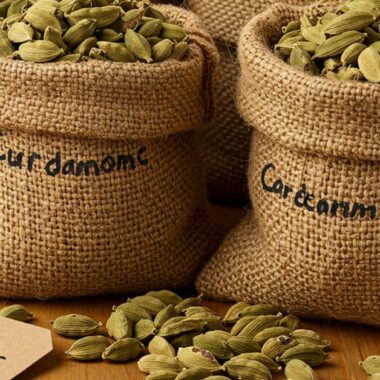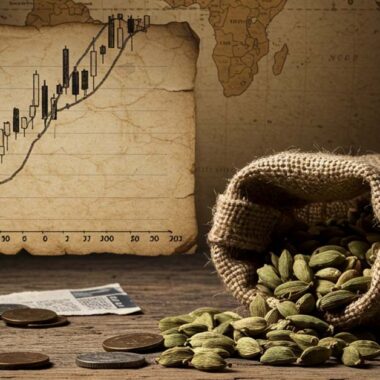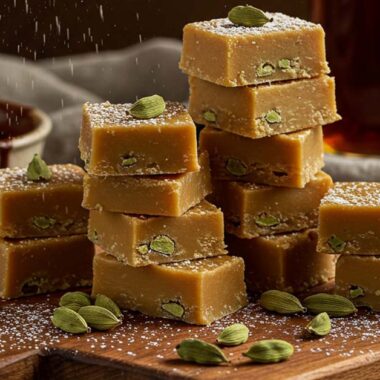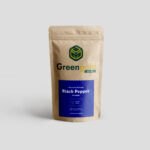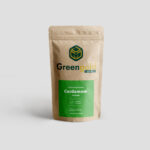Cardamom, often called the “Queen of Spices”, has played a major role in shaping Arabian trade routes for centuries. This aromatic and valuable spice was highly sought after in the Middle East, traveling across deserts, seas, and bustling marketplaces as part of the lucrative spice trade. The influence of cardamom in Arabian commerce extended far beyond its culinary use—it was a symbol of wealth, a medicinal treasure, and a key ingredient in Middle Eastern traditions.
Let’s explore how cardamom became a cornerstone of Arabian trade routes, connecting civilizations from India to the Mediterranean and beyond! 🚢✨
🏜️ Cardamom’s Journey Across the Arabian Spice Routes
The Arabian Peninsula was a vital center for global trade, acting as a bridge between India, Persia, Africa, and Europe. Arabian merchants were famous for their control over spice routes, especially those involving high-value commodities like cardamom, frankincense, myrrh, and cinnamon.
🛤️ The Land Route: The Incense Road
One of the most famous trade routes, the Incense Road, connected the southern Arabian Peninsula (modern-day Yemen and Oman) with the Levant (modern-day Syria, Jordan, and Israel).
- Cardamom was transported by caravans of camels, passing through major cities like Mecca, Medina, and Petra.
- Arabian traders bought cardamom from Indian merchants in ports like Aden before carrying it across deserts to Middle Eastern and Mediterranean markets.
🌊 The Maritime Route: Indian Ocean Trade
Arabian traders were also skilled seafarers, dominating the Indian Ocean trade routes.
- Ships from Yemen, Oman, and the Persian Gulf sailed to Kerala and Sri Lanka, where they sourced high-quality cardamom from the lush forests of the Western Ghats.
- These ships returned to Arabian ports, where cardamom was either consumed locally or re-exported to Egypt, Persia, and the Roman Empire.
💡 Fun Fact: The word “cardamom” comes from the Greek “kardamomon”, but the spice itself reached Greece and Rome via Arabian traders! 🏺
🏺 Cardamom: A Symbol of Wealth & Status in the Arab World
Arabian traders understood that cardamom was more than just a spice—it was a luxury item. The spice became a symbol of prestige, often used by royalty, scholars, and wealthy merchants in the Islamic Golden Age.
- Arabian merchants controlled the cardamom trade, keeping its supply limited and prices high.
- In medieval Islamic courts, cardamom was an essential part of lavish feasts and medicinal recipes.
- It was gifted to rulers and dignitaries, reinforcing its status as an elite commodity.
☕ Cardamom in Arabic Coffee Culture: A Timeless Tradition
One of the most enduring influences of cardamom in Arabian trade is its role in Arabic coffee (Gahwa). This tradition dates back centuries and remains a symbol of hospitality in Arabian society.
- Cardamom-infused coffee was served to honor guests, traders, and travelers in desert caravans and royal courts.
- Even today, Arabic coffee is brewed with green cardamom pods, giving it a distinct spicy-sweet flavor.
- In many Middle Eastern homes, offering cardamom-laced coffee is a sign of respect and warmth.
💡 Fun Fact: The Arabian Peninsula is considered the birthplace of coffee, and the combination of coffee and cardamom became a global phenomenon thanks to trade! ☕🌿
⚕️ Cardamom in Arabian Medicine & Perfumes
Arab scholars and physicians, including the famous Avicenna (Ibn Sina), documented the healing properties of cardamom in their medical texts.
- It was used to aid digestion, freshen breath, and treat respiratory ailments.
- Traders carried cardamom-infused oils and perfumes, which were highly prized in Middle Eastern markets.
- It was an important ingredient in medieval Islamic herbal remedies.
💡 Fun Fact: The Middle East was a hub of scientific advancements during the Islamic Golden Age, and cardamom was often included in pharmaceutical formulations.
🌍 The Spread of Cardamom Beyond Arabia
Arabian traders played a crucial role in introducing cardamom to new markets, spreading its influence across Europe, Africa, and Asia.
- Egyptian markets became major centers for cardamom trade, supplying it to the Greeks and Romans.
- Venetian merchants bought cardamom from Arab traders and sold it in medieval Europe, where it was considered an exotic luxury.
- Ottoman and Persian traders further expanded its use in Persian tea, Turkish coffee, and Middle Eastern cuisine.
💡 By the 15th century, cardamom was one of the most expensive spices in the world, rivaling saffron and cinnamon!
🛍️ Experience the Legacy of Arabian Trade with Premium Cardamom!
From the ancient spice routes of Arabia to your kitchen today, cardamom remains a prized ingredient. Enjoy the rich history and luxurious flavor of this timeless spice by getting high-quality cardamom from Greengold Guide! 🌿✨
Whether in your coffee, cooking, or herbal remedies, savor the spice that shaped centuries of trade, culture, and tradition! 🚢🏺

